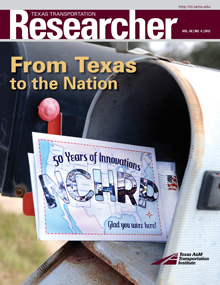
On Sept. 26, 2012, at the Texas A&M Transportation Institute’s (TTI’s) Riverside Campus crash facility, a fully loaded 18-wheeler traveling at 50 mph slammed into a concrete barrier placed on top of a retaining wall. The data from the unique crash test will prove vital for increasing safety and decreasing construction costs for this type of barrier application. The test was broadcast across the country via the Internet as a first-ever streaming event.
The mechanically stabilized earth (MSE) wall — where a truck barrier sits atop a retaining wall — is being used more often by state departments of transportation. TTI Research Engineer Roger Bligh and his team of researchers, including renowned geotechnical expert Jean-Louis Briaud, measured the impact of the collision on the barrier system and MSE wall as a key task on NCHRP 22-20(02): Design Guidelines for TL-3 through TL-5 Roadside Barrier Systems Placed on MSE Retaining Walls. Bligh, manager of TTI’s Roadside Safety Program, and Briaud are co-principal investigators on the project.
Findings from this first-of-its-kind crash test will have major implications. “There is no information available that tells industry how to design the barrier foundation system and the retaining wall to accommodate an impact from a large commercial truck,” Bligh notes.
According to Briaud, manager of TTI’s Geotechnical and Geoenvironmental Program, retaining walls have become more popular due to space limitations in and around urban areas. “Those walls, and the concrete barriers on top of them, are necessary when there is no room for earthen slopes. But until now, researchers and construction companies could only guess the force that’s applied to the wall from a fully loaded 18-wheeler.” Briaud conducted computer simulations of crashes for months on the project.
Without guidelines to help determine the appropriate size and type of wall and barrier, road designers and construction firms were often overly conservative in their choices. Bligh says the data from the test will help take the guesswork out of the equation.
Peter Anderson, vice president for technical development of the Reinforced Earth Company (RECo), a design and supply firm considered a market leader in the MSE retaining wall industry, assisted with the project. Bligh says RECo’s involvement in the test dramatically lowered project costs thanks to the donation of materials needed for the test installation.
Attending the crash test was Mark S. Bush, NCHRP senior program officer overseeing the research project. Bush says numerous steps have to be taken before new guidelines for this application will be adopted.
“Now that this critical crash test has been conducted, TTI will complete the analyses and finish a detailed final report to be reviewed by an expert NCHRP panel for publication and committees from the American Association of State Highway and Transportation Officials for adoption,” Bush says. “This was a crucial test for refining barrier design procedures and standards to ensure the safety of the traveling public.”

